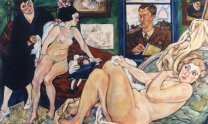
Suzanne Valadon 1865-1938 CE
Oil, 91 x 152 cm
$3,500
Suzanne Valadon worked from eleven years of age to supplement her mother's income, and became an artists' model at fifteen. She used this opportunity to observe and learn the artists' techniques. As a working-class woman she was not barred from the bohemian cafes where early modernist art ideas were discussed, nor later prevented from painting the nude. Valadon exhibited successfully for most of her life, working at her easel until her death at seventy-two.
Valadon's reputation is currently being reclaimed. Hers is a salutary example of how quickly women can be written out of history.
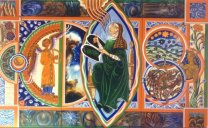
Hildegard of Bingen 1098-1179 CE
Oil, 152 x 244 cm
$7,500
At the age of eight Hildegard was given to be raised in the church, eventually becoming the abbess of two large convents. She experienced astounding religious visions, wrote histories, a medicinal, the first morality play, 77 songs, music, and copious letters, many on spiritual concerns, and embarked on four journeys to preach reform.
Her life, her work, her spirit and her music make her the ideal patron saint of women who write, compose, sing, perform, paint, draw, heal, philosophise, or study the earth or stars. The example of her spiritual leadership challenges us to consider Sophia, the Principle of Wisdom.
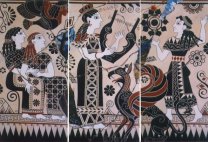
Sappho of Lesbos c. 615 - 560 BC
Oil, 152 x 228 cm
SOLD
Almost all we know of Sappho comes in the form of mysterious fragments - scraps of parchment, shards of pottery and quotes from later writers. No signed works or contemporary accounts of her life or performances remain. But what has endured, since the very beginnings of western civilisation, is the strength of her reputation as a poet.
Ancient Greek literature celebrated the exterior - epic tasks, war, glorious deeds. Sappho, however, took the interior journey, exploring feelings, responses and remembered pleasures. In this way a pivotal idea in western thought, the concept of individual self, took poetic form.
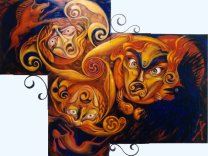
Boudica (Boadicea) c. 21 - 61 CE
Oil, 147 x 193 cm
$2,500
Boudica, queen of the Iceni, led her warriors to victory against an entire Roman legion, gathered to her cause 100,000 people from several Celtic tribes and burned to the ground three Roman towns, including Londinium (London).
Roman brutality, forced acquisition of lands, insensivity to Celtic protocol, and persecution of Celtic religious systems had thoroughly antagonised the Iceni and their neighbours. The massive rebellion triggered by assaults on the bodies of Boudica and her daughters was not merely a revolt by undisciplined tribes but the clash of two powerful belief systems. Under Boudica, the Celts came close to ousting the Romans from Britain.

Mary Magdalen c. 5 - 75 CE
Oil, 152 x 167 cm
$5,500
Mary Magdalen is named amongst the women who followed Christ, is mentioned in the crucifixion story, and is identified as the first witness to the resurrection. She is also the most consistently maligned woman in western history, devalued by identification with the "sinner" who anointed the feet of Christ, and with legends of the penitent whore.
Evidence of women's independence and leadership in the early church challenges the Jewish and Graeco-Roman legacies which have both defined the role of women in western culture. The importance of Mary Magdalen and her part in that history is now undergoing radical re-assessment.
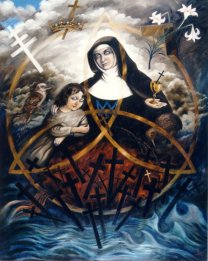
Mary MacKillop 1842 - 1909
Oil, 122 x 152 cm
SOLD
Mary MacKillop was born in Melbourne to Scots highlander immigrants. Her youthful experience of the destitution faced by women and children abandoned for the goldfields evoked Mary's compassion and helped form the idea of a religious vocation. She took vows as the first member of the Order of Saint Joseph in 1866.
Despite persistent opposition to her egalitarianism, Mary's life is an astonishing story of victory through faith, bringing education to poor Catholic families, providing shelter for homeless women and children, and caring for the suffering and underprivileged.